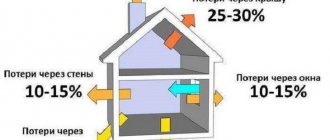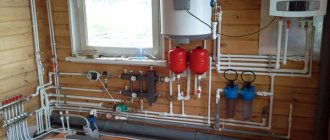Due to the high tariffs for the services of gas supply organizations, economical gas consumption is a sore point for most families living in a house with gas heating. The amounts on gas bills, especially in winter, can be simply unrealistic, right? Have you thought about how to save gas in a private home without sacrificing a comfortable microclimate?
We will try to help you solve this issue - in this material we will tell you about real ways to save money, tested by many consumers in practice. We will also consider alternative heat sources that can complement or completely replace gas in a private home.
What affects fuel consumption?
Combined gas stove. Photo by OZON
Gas is used for cooking, heating and water heating for general use. To figure out how you can save gas, you need to understand where it goes.
When heating, gas is used to heat the room. The more problems there are in the room, the more gas is consumed. Problems should include shortcomings ranging from an uninsulated attic and walls to cracks in window frames. The warmer the room, the less gas will escape. An additional burden on this part of the costs can also come from heated floors connected to the main heating.
Boiler clocking
Clocking is the frequency of switching on equipment for heating the coolant. If no external control devices are connected to the baxi boiler, the interval between turning on the boiler can be set to a maximum of 10 minutes (default 3 minutes).
For example, for the BAXI ECO FOUR boiler, configuration parameter F11 is responsible for this. Burner waiting time between two starts.
Frequent switching on is not economical - the more time the boiler operates continuously, the better. On one of the forums, a user expressed concern about the long-term continuous operation of the boiler, but this, on the contrary, means that a mode has been established in which the heat losses of the room are continuously compensated while maintaining the optimal coolant temperature.
This problem is most pressing for owners of small-sized apartments, because the boiler was initially designed for the preparation of hot water and obviously higher power.
Since the configuration parameter numbers of gas boilers may differ, to configure a specific model you need to study the instructions.
Basic saving measures
Cooking food:
- Use the stove only after all products have been prepared for heat treatment. When cooking is finished, the burners must be turned off immediately.
- Use tight-fitting lids during cooking.
- Before cooking, boil water in a kettle and pour the hot water into the pan.
- Make sure that the flame does not leave the container. You can make it a rule to use appropriately sized utensils and burners.
- Use overhead “pancakes”. They evenly distribute heat over the bottom surface and enhance the heating effect of fire.
- If the stove is old, it is better to replace it with a more modern one.
- Use the gas stove only for cooking.
Fan heater. Photo by OZON
Heating a private house:
- Insulation of the room: walls, floor, attic, entrance doors.
- Installation of double-glazed windows that will maintain airtightness. Also, do not forget about the cracks that need to be sealed.
- Install an independent separate boiler for water heating.
- Place heat-reflecting foil elements between the heating radiator and the wall.
- It is better to replace old and less efficient batteries with optimized modern ones.
- Installing an automated temperature control system will help maintain a comfortable temperature in the right rooms at the right time without overheating empty rooms.
- Inspect and, if necessary, clean the heating system at least once.
- A ventilation device that will leave warm air in the room. A hood with a recuperator can also handle this.
See also : How to save gas in a private home with gas heating
Analysis of heat losses and ways to reduce them
In a private house, the greatest amount of heat is lost through windows, walls and roof. In addition, a certain amount of thermal energy is lost with the escaping air through the ventilation system, because warm air is replaced by cold outside air. Therefore, the following ways to save on heating are:
Firstly, insulating the roof or attic - using stone wool, foamed polymers, covering the roof with sandwich panels. In each specific case, the choice is made based on the characteristics of building structures and the solvency of the owner.
Secondly, reducing heat loss through windows. There are two acceptable methods here. The first is to reduce the total window area of the entire house, but at the same time reducing the amount of sunlight entering the premises. The second way is to install windows with better energy performance. These are windows with double and triple glazing, multi-circuit window systems and special windows, the glass of which is coated on one side with a thin layer that reflects infrared radiation.
Thirdly, insulating the walls of the house or constructing them from materials with better thermal characteristics.
Fuel saving devices
There are several options for appliances: Gas Saver, thermostats and condensing boilers.
Gas Saver
It is better to purchase Gas Saver immediately with the purchase of a thermostat. It is a device based on a magnet. It is installed at the base of the pipe where the hose is screwed on.
The principle of operation is that gas molecules passing through the pipe are broken up under the influence of a magnetic field into an ordered structure. In this form, gas is consumed most efficiently.
The device helps save up to 30% fuel.
In addition, the advantages of Gas Saver include:
- no need to monitor the operation of the device;
- its small size will not spoil the interior; in extreme cases, it can be easily decorated;
- installation does not require special skills or experience;
- It's inexpensive.
Among the disadvantages are:
- inability to customize the device to suit your needs;
- the correctness of the installation and the results of the work will be noticeable only by the figures in the utility bills.
Important!
Homemade magnetic devices can damage gas meters. Read here about economical gas meters.
Thermostats
Thermostat. Photo by OZON
A thermostat is a programmable gas saving device. Its task is to turn off and turn on the boiler when a threshold temperature value is reached. That is, as soon as the air in the room cools down to the user-programmed value, the thermostat turns on the boiler. On the contrary, when the room temperature becomes higher than the specified one, the device turns off the boiler.
Helps save up to 20% of consumed heat. The advantages also include:
- maintaining a comfortable temperature without constant monitoring of the boiler;
- quick payback for the device - in two months the device will recoup its price;
- eliminates the disorder of the boiler's on-off cycles, thereby extending its service life;
- There are different types of thermostats for specific needs and capabilities.
Attention!
If the room doesn't retain heat well, a thermostat won't be very effective. It works well only in combination with other gas saving measures.
The disadvantages of a thermostat include:
- the device requires careful handling, since its sensors can easily be damaged;
- each room requires its own thermostat, and the doors between these rooms must be closed so that the temperature does not equalize;
- requires the correct installation location.
Condensing boilers
A condensing boiler is a more advanced gas boiler with two chambers. It uses the energy of condensation formation during fuel combustion. The principle of its operation is quite simple: exhaust gases are sent from the first chamber to the second, where they begin to heat the cooled combustion products. In this case, condensation forms, which is collected in a special tank.
Savings when using a condensing boiler will be 30 - 35%. This type of boiler has other advantages:
- more environmentally friendly than conventional boilers;
- noise and vibration levels are also lower;
- part of the heat exchanger is itself cleaned with condensate, and the design of the boiler itself minimizes its need for cleaning;
- the total weight of the equipment is lower.
The only drawback of such a boiler is its cost, which will not pay off as quickly as a thermostat.
Professional advice on saving gas for heating needs
Even when installing the most advanced heating system in a house, gas consumption significantly depends on the ability to properly operate boiler equipment. It has been proven that with equal power indicators of the boiler unit, the consumption of blue fuel differs among different users.
There are several effective energy efficiency measures that help owners achieve the desired amount of fuel savings:
- Thermal insulation of external structural elements of the house.
- Replacement of window units with new energy-efficient ones or reliable sealing of existing wooden frames.
- Installation of energy-reflecting screens between the wall and the radiator.
- Performing thermal insulation of the boiler unit and boiler and pipe system, which are located in an unheated furnace room.
- Annual cleaning of boiler heating surfaces from external contaminants, soot and internal scale.
Following these simple tips will save your gas consumption by up to 30%.
Ways to save at home
There are several options for saving: from selecting a heating system to upgrading a gas boiler.
Selection of heating system
Radiator controller. Photo by AliExpress
To select a heating system, you must go through 6 steps:
- Calculation and measurement of heat loss at home. To do this, you can use various online calculators that will ask for the area of the walls, the thickness and type of its layers, and the type of facade. If you divide the result by the square footage of the room, there will be heat loss in W per m². On average they are in the region of 50 - 150 units.
- Selecting temperature mode. This can be European mode, low temperature and others. Imported ones are set to 75° at the water outlet from the boiler, 65° at the inlet and 20° room temperature.
- Calculation of radiator power. Based on the results of the first step and the second step, and the data of the selected manufacturer, radiators are selected to suit your characteristics and needs.
- Calculation of pipe diameters and characteristics of the circulation pump.
- Boiler selection.
- Calculation of system volume. Online calculators will help with this. If the previous steps have been completed, it will not be difficult to calculate the need for additional capacity for the boiler.
Attention!
It is important to take into account warm water floors in the calculation.
Insulation of the gas meter
The method is based on the laws of physics and a meter installed on the street, but is not effective. The lower the temperature of the incoming gas, the higher its density.
Nowadays, thermal correctors are installed in meters that take this feature into account and give readings in accordance with them. If the meter is installed without a thermal corrector, then the management company itself carries out the recalculation. Insulating the meter does not provide a noticeable increase in benefits.
Gas boiler modification
Digital thermostat. Photo by AliExpress
Modification of a gas boiler will increase its efficiency. There are several methods:
- Installation of a turbulator - plates that increase the area of heat energy extraction.
- Find the most optimal position of the blower damper. This will ensure maximum combustion of gas in the chamber.
- Keeping the boiler clean. This applies to all its parts.
- Reducing heat loss from the boiler itself. This is the use of a wall-mounted boiler instead of a floor-standing one, the correct selection of heating equipment.
Setting up automation Eurosit 630
Configuration is carried out after mounting the system. Adjustment is carried out using a knob. It switches the boiler to 3 positions: switching on, ignition and temperature mode.
To turn on the automation, the knob must be turned to the ignition position. When pressed, the piezoelectric element will be activated, which will ignite the pilot burner. You should hold this position for ten seconds to half a minute. After releasing the button, the igniter should stop working.
For more information about this automation, see the article Gas automation Eurosit 630.
Warm floor
Depending on the type of flooring, you will have to choose between water, infrared and electric flooring. The last two can be turned on instead of the main one, instead of the main heating, when it’s just cool outside.
Reference
A water floor will allow waste water from the boiler to be used more efficiently.
How you can save gas using a thermostat
Modern gas boilers can be equipped with various types of thermostats. There are simple models, and there are complex ones, with various additional functions. The most sophisticated model today is a thermostat with sensors that monitor the temperature outside. The slightest changes in weather conditions are immediately transmitted to the boiler. You can purchase thermostats for each battery. Each room needs a different temperature, so they should be heated differently. This is exactly what the thermostat will do.
Installation of a high-quality ventilation system
A well-planned ventilation system also allows you to save gas correctly. The ventilation system removes not only exhaust air from the room, but also heat. If it is properly planned, then heat loss will be minimal.
To save gas, purchase a recuperator. It is a pipe within a pipe. The inner pipe removes heat from the house, and fresh air enters between the gaps of the two pipes. The warm internal air that is inside heats the air that flows between the gaps. This saves gas significantly.
No. 1. Install a gas meter
We all know that resource tariffs are greatly inflated. In addition, they are calculated separately for each person registered in the apartment. Thus, the first question that arises is: how to pay for actual consumption? The answer is simple: installing an individual meter. In this case, a gas meter.
Without its installation, all other advice will be meaningless: although you will reduce actual gas consumption, you will still pay according to the standards, overpaying several times.
IPUs come in different types and differ in their operating principles. We have prepared a separate article on choosing a meter, where we examined the most important characteristics that you need to pay attention to. In short, be sure to pay attention to the throughput of the device: for this you need to know the number of gas appliances in the house and their consumption. We recommend taking the electronic version with a remote display for convenience. If you plan to install the meter outdoors, then be sure to check the presence of a thermal corrector.
After installation, record the meter readings in a notepad (some models allow you to enter the history electronically). This way, you can determine for yourself the amount of fuel saved and the effectiveness of our advice.











